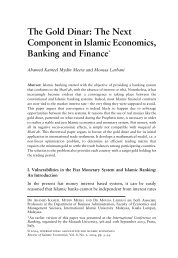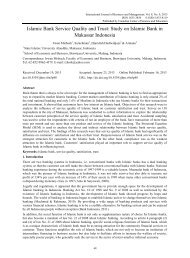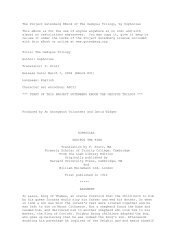The Oil Industry in Nazi Germany, 1936-1945
The Oil Industry in Nazi Germany, 1936-1945
The Oil Industry in Nazi Germany, 1936-1945
You also want an ePaper? Increase the reach of your titles
YUMPU automatically turns print PDFs into web optimized ePapers that Google loves.
NAZI OIL INDUSTRY 269<br />
hydrogen gas are needed for any of the major chemical synthesis pro-<br />
cesses, <strong>in</strong>clud<strong>in</strong>g synthesis of ammonia, methanol, nitric acid, rubber,<br />
and fuel. <strong>The</strong> hydrogen gas is generally produced by pass<strong>in</strong>g steam<br />
through electric current. In addition, carbon monoxide is needed, es-<br />
pecially for the Fischer-Tropsch process, and is produced by burn<strong>in</strong>g<br />
coal or coke. Thus the cost of produc<strong>in</strong>g hydrogen or the synthesis gas<br />
(a mixture of hydrogen and carbon monoxide)--closely related to the<br />
cost of coal and coke for both energy and raw materials-is a key ele-<br />
ment <strong>in</strong> determ<strong>in</strong><strong>in</strong>g the f<strong>in</strong>al cost of synthetic fuel production.41<br />
As Table 1 shows, the two processes differed <strong>in</strong> the amounts of coal<br />
<strong>in</strong>put required. <strong>The</strong> major difference arose <strong>in</strong> the amounts needed for<br />
the production of synthesis gas or hydrogen. Because higher-quality<br />
(and thus more expensive) coal or coke was needed <strong>in</strong> hydrogen/syn-<br />
thesis gas production than <strong>in</strong> other operations, this discrepancy had a<br />
significant <strong>in</strong>fluence on the difference between the two processes <strong>in</strong><br />
total production cost. It is also important to look more closely at Bii-<br />
tefisch's figures on plant costs. Along this dimension the Fischer-<br />
Tropsch process cost less per ton than hydrogenation. For the Fischer-<br />
Tropsch process, Buitefisch observed, at least half of total plant costs<br />
were related to the construction and ma<strong>in</strong>tenance of a large synthesis<br />
gas plant for the production of hydrogen and carbon monoxide. <strong>The</strong><br />
major costs <strong>in</strong> a hydrogenation plant, <strong>in</strong> contrast, were related to the<br />
construction and ma<strong>in</strong>tenance of high-pressure reactors that could<br />
withstand the extreme temperatures and pressures of the hydrogena-<br />
tion reaction; facilities for the production of hydrogen were less im-<br />
portant <strong>in</strong> the determ<strong>in</strong>ation of plant costs.42<br />
Biitefisch's rough calculations allow no precise comparison of the<br />
cost of hydrogen or synthetic gas for the two major fuel synthesis pro-<br />
cesses. Nonetheless, Table 1 reveals that coal costs were much higher<br />
for the Fischer-Tropsch process than for hydrogenation. Furthermore,<br />
the facilities necessary for the production of synthetic gas <strong>in</strong> a Fischer-<br />
Tropsch plant were a much larger factor <strong>in</strong> plant costs than those for<br />
the production of hydrogen <strong>in</strong> a Bergius plant. <strong>The</strong> end result of these<br />
differences was a cost differential of about 20 percent between the two,<br />
with the products of the hydrogenation process by far the cheaper.<br />
<strong>The</strong> overall cost difference between the two fuel synthesis processes<br />
cannot be expla<strong>in</strong>ed fully by differences <strong>in</strong> the size of the respective<br />
operations. Biitefisch's examples are both drawn from large-scale<br />
" "Synthesegas aus Braunkohle," Chemische Industrie 59 (May <strong>1936</strong>), 106; Tammen, I. G. Farben-<br />
<strong>in</strong>dustrie, 37.<br />
'2 BIOS 1697, Synthetic <strong>Oil</strong> Production, 15.












